The Grey Duster fly sits on my short list of the greatest dry flies to have been invented. As such, it will always have…
Pride of Place in my dry fly box
As I’m sure, it does in the fly boxes of many accomplished fly anglers.
For close to 40 years, this classic dry fly has often produced the GOODIES (trout & grayling) for me on most of the rivers I’ve fished, especially the…
Dee, Eden, Ribble, and Wharfe.
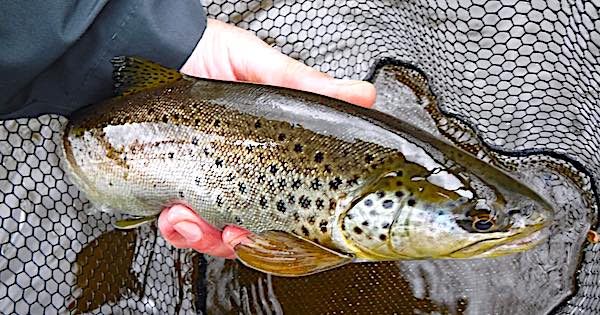
It’s also a fantastic midge fly imitation for stillwater trout fishing when tied on size 18 & 20 hooks, which I believe is what it was originally designed for.
So, which dry fly patterns do I regularly tie and fish…
How to tie the classic grey duster fly
Material list:
- Hook – HENDS BL354 (#14 to 20)
- Thread – Grey 8/0
- Tail – (optional) a few Badger cock fibres
- Body –Rabbit underfur
- Hackle – Badger cock
Step-by-step fly tying instructions – Classic Grey Duster fly:
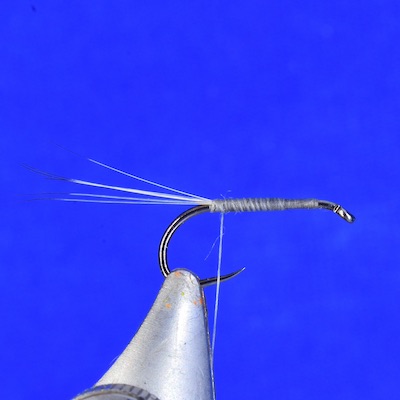
Step 1. Place the hook firmly in the vice and start the thread and wind down to the bend. Select a small bunch of Badger cock hackle fibres (4 or 5) for the tail and tie them in.
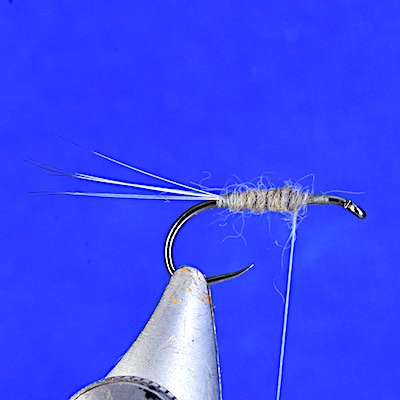
Step 2. Next, dub the thread with the rabbit underfur to form a tapered rope, and wind it up the shank in touching turns, stopping roughly 1/3 the length from where you started the thread.
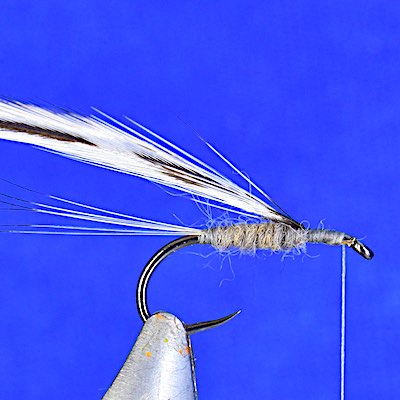
Step 3. Select a feather for the hackle that has fibres about 1.5 x the length of the hook gape. Strip a portion of base fibres from the butt of the feather to provide a clean tie-in point. Using this point, tie in the hackle with the glossy side facing upwards, and the feather extends back along the shank.

Step 4. Take hold of the hackle with a pair of hackle pliers and with a little tension wind in neat touching turns towards the eye. When complete, tie down with three wraps of thread and clip off the waste. Form the head of the fly with the thread, whip finish, and varnish.
How to tie a Parachute style Grey Duster fly
Material list:
- Hook – HENDS BL354 (#14 to 20)
- Thread – Grey 8/0
- Tail – (optional) a few Badger cock fibres
- Wing Post – single CDC feather
- Body – Rabbit underfur
- Hackle – Badger cock
Step-by-step fly tying instructions – Parachute Grey Duster fly:

Step 1. Place the hook firmly in the vice and start the thread and wind down to the bend. Select a small bunch of Badger cock hackle fibres (4 or 5) for the tail and tie them in.
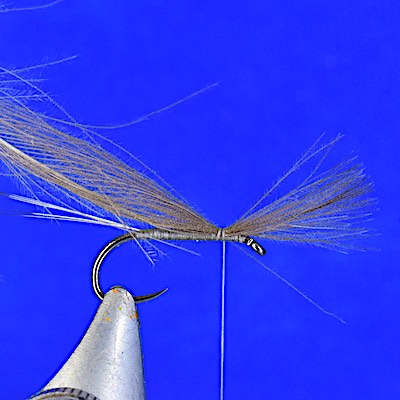
Step 2. Select a CDC feather and tie it in by its tip. Adust the length of the wing post by pulling the feather back under the thread.
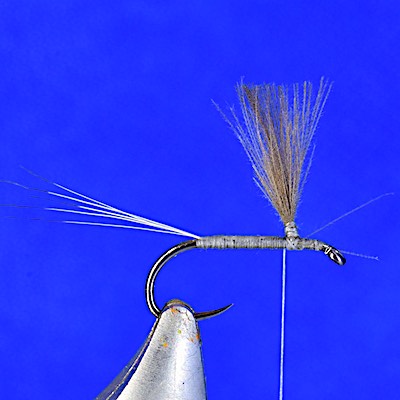
Step 3. Fold the stem of the CDC feather up to form part of the wing post and secure it with 4 turns of thread. Remove the excess stem by cutting it up at a 45-degree angle.
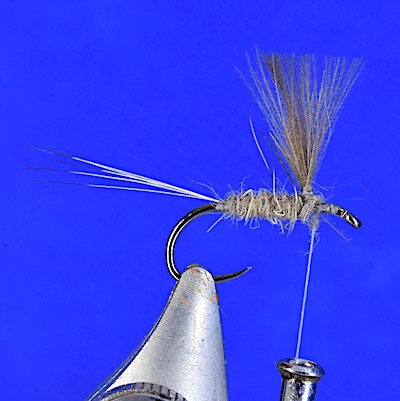
Step 4. Next, dub the thread with the rabbit underfur to form a tapered rope and wind it up the shank in touching turns, stopping by the wing post.
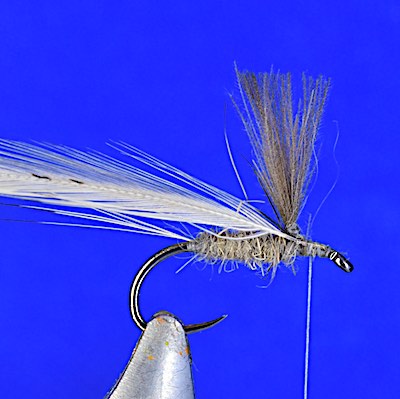
Step 5. Select a feather for the hackle that has fibres about the length of the hook shank. Strip a portion of base fibres from the feather’s butt to provide a clean tie-in point. Tie in the hackle with the glossy side facing upwards with the feather extending back along the hook shank.
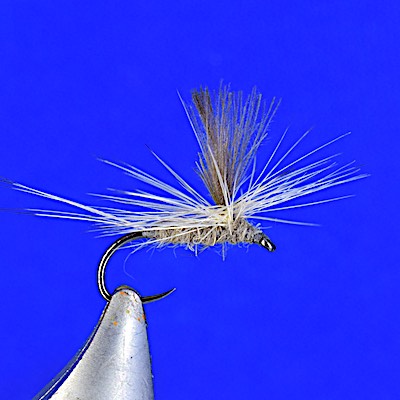
Step 6. Take hold of the hackle with a pair of hackle pliers, wind around the post to form the hackle, and tie off the waste end. Apply a pinch of rabbit underfur to the thread and form the thorax. Form the head of the fly with the thread, whip finish, and varnish.
When and how to fish the Grey Duster fly
I use the Grey Duster as a fantastic searching dry fly pattern for trout and grayling, especially when it’s unclear what they’re feeding on.
The fly was originally designed as a stillwater midge imitation, but it’s excellent at fooling grayling and trout on the Welsh Dee. Especially those fish taking small flies in the tails of pools.
Also, I find it an effective pattern during a variety of olive hatches on rivers. It just seems to have…
FISH FOOD – written all over it!
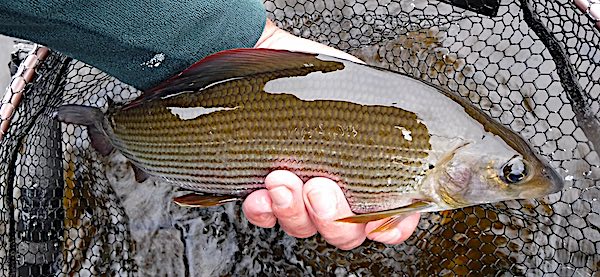
In broken water (riffles and runs), I usually fish the classic pattern (sizes 16 &14) because it rides high on the surface and is easier to spot.
Whereas, on glassy glides and tails, the parachute pattern (size 16 to 20) sitting in the surface film leads to fewer missed takes.
Equipment-wise, I use a 9ft 5# rod for dry fly fishing. Attached to the floating line is a 9ft 5X copolymer leader tipped with a 3 to 4 ft length of 3lb fluorocarbon. Fuller’s mud is applied to the fluorocarbon tippet to remove its shine and make it sink. Whereas, Mucilin grease is applied to the remainder of the leader.
Finally, I hope this article stimulates you to tie either the classic or parachute Grey Duster fly and test it on your local river or take a trip to fish the Welsh Dee, where it catches fish when other flies fail.
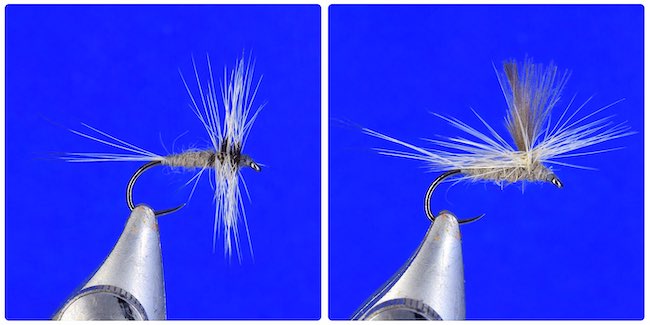
Great article Andrew. Very informative as usual . Love the Duster caught many wee brownies .
Hi Tim,
Glad you enjoyed the post.
Thanks for the comments, Andrew
Excellent article….keep up the good work.
Cheers
Here in Ireland we tie the duster on dirty great size ten’s and fish them as a mayfly pattern. One on the all time greats!
Hi Colin,
That’s great to know. I will tie a few and give them a try.
Cheers, Andre
Jo
Excellent article, thanks.
Great to hear you enjoyed it. Cheers.
Hello Andrew, I enjoy your fishing experiences. I live in Atlantic Canada. I however am an Atlantic Salmon fly fisherman and have been for over 60 years. I do some fishing for sea run trout rhat is just starting now.
Enjoy your work, thank you.
Great to hear you are enjoying my blog posts. Tight lines, Andrew
Clear, concise and really helpfully presented – just the job1 thanks Andrew 😉
Thanks
Looks a nice fly will try this on the hodder next week. By the way when you fish the ribble is it on day ticket . Cheers Mike
Hi Michael,
I normally fish the PAAS beats of the Ribble.
Cheers, Andrew
Hi Andrew, as a new member of the BDSA I find your blog invaluable and save all you publish , they are great. only fished the Dee at Bangar once so far and it is a lovely river. keep up the great work. thanks. Paul
Hi Paul,
Pleased to hear you are enjoying the post.
Thanks, Andrew
Hi Andrew, nice article about one of my favourite flies. I usually tie mine without a tail and a slightly darker hackle. Works well for me on the Usk. I think it works because it resembles just about everything. Tight lines.
Alan
Great article, really enjoyed reading it! My favourite fly for autumn grayling on the W. Dee is a size 20 GD; if fish are rising, it never fails!
Great to hear you enjoyed it. Cheers, Andrew
Hi Andrew,I’ve always had success on the Grey Duster no matter where I fish.
My personal touch is to use a Heron’s Grey Herl for the bodywhich gives it a slender body yet imparts the abdoment image well.
Thanks for all your tips and advice too!
Hi Keith,
Thanks for the tip on how you tie the fly – I will give it a go.
Cheers, Andrew
Catches fish when other fly don’t. Angling luminaries Dennis Moss and Bob Wyatt both extoll the virtues of this old classic.
Like many of the old classic flies – they just work.
Enjoyable article. Thank you.
Hi George,
Great to hear you enjoyed it.
Tight lines, Andrew